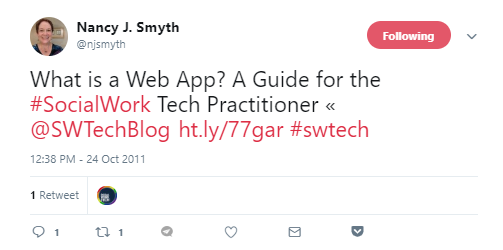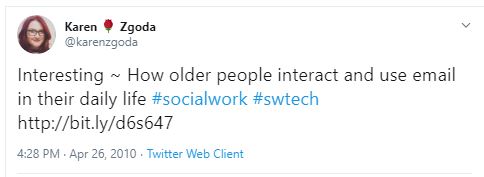#SWTech – An Introduction and History of the Online Group
Editor’s Note: This blog post was written by the following users of the #SWTech Community – Melanie Sage, Assistant Professor of Social Work at the University at Buffalo; Laurel Iverson Hitchcock, Associate Professor of Social Work at the University of Alabama at Birmingham: Jonathan B. Singer, Associate Professor of Social Work at Loyola University and founder of the Social Work Podcast; and Nancy J. Smyth, Professor & Dean at the School of Social Work at the University at Buffalo.
This is an introduction to #SWTech, an online network of social workers interested and engaged with technology for social good. Our goal is to help individuals new to #SWTech learn about the norms, history, and general merrymaking within the community. This statement can also service as a resource to send people who are interested in learning more about #SWTech.
Description
#SWTech is a hashtag used by people and groups interested in the intersection of social work and technology. People use #swtech primarily on Twitter, but the hashtag is occasionally used on other social media platforms such as Facebook or Instagram. This hashtag is used in tweets and other posts on social media to share about such topics as:
- Teaching with technology (#edtech also relevant)
- Practice with technology
- Technology that impacts social justice issues
- Ethical issues at the intersection of tech and well-being
- Social Work through a Futuristic lens
- Conference sessions related to the tech/social work intersection
Additionally, there is an open group on Mighty Networks called Social Work and Technology, which serves as a hub for anyone who believes that technology can and should be used by social workers to make the world a better place.
There is no process for “membership”- participation is an entirely elective opt-in process. Several of the long-time active users of the hashtag have become informal ambassadors for encouraging activity and supporting community outreach. All are welcome to join in those activities. One typically identifies as a “member” of the community by participating in conversations over time, joining in collective action, and/or joining in conference activities. The most active users sometimes connect in person, primarily at social work conferences like CSWE’s Annual Program Meeting or the Social Work Distance Education conference, and announce or organize conference meet-ups via Twitter. There is no formal process for this; someone typically volunteers to take the organizer lead via Twitter and others volunteer to support.
A Brief History
It’s not really clear when the #SWTech hashtag started, although Nancy Smyth has a vague memory of beginning to use the hashtag on Twitter to model it after the #EdTech hashtag she followed. On March 2, 2011, she tweeted “Creating Your Digital Social Work Tool Box (by @swtech) http://ow.ly/4mhG2 great tutorial #socialwork #swtech” — at some point she downloaded her tweets from 2009-2017, and that’s where she found it.

In fact, it looks like Karen Zgoda, a social worker and founder of #MacroSW, used #SWTech for the first time in 2010 when tweeting about how older adults were using email almost ten years ago:

Membership
Twitter is an open network, and as such, anyone can use the #swtech hashtag. Presently, the hashtag is most frequently used by social work instructors who are interested in teaching about technology and with technology. Participants include several social work practitioners, and social work students often join in conversations. We welcome any people who are curious about the intersection of social work and technology. As with any hashtag on Twitter, the best way to make one’s presence known is to reply to people, retweet good posts, and follow people- use of the hashtag alone is not likely to lead to interaction. Awareness of the hashtag norms about how people communicate is most likely to lead to positive interactions.
For more information about the history of #SWTech, check out Laurel’s blog post #SWTech: The Beginnings of an Online Community.
Norms
Twitter has its own set of norms (such as hashtags, use of memes) that differentiate it from other social networks, and groups on Twitter also have their own sets of norms that are often implicit but practiced through modeling. Typically, this group has functioned by reliance on relational communication, supporting colleagues with helpful posts and supportive resources, and both online and in-person engagement. The following types of engagement seem to elicit positive group communication:
- A balance of self-promotion (books and articles, for instance) with helpful resources, providing more of the later than the former.
- Retweet, reshare, and honor the important contributions of colleagues.
- Asking permission from presenters at social work conferences or other presentations to tweet out and share their content in order to promote accessibility of conference innovations.
- Collaboration with other #swtech users on presentations, papers, and other projects, and it is customary to reach out to colleagues with common interests by direct messaging (DM) them about collaborating or communicating offline.
- Support for “call-in” culture. This means that if a colleague who is an active user of the #swtech hashtag behaves inappropriately or with prejudice in a way that is unknowing or naive, or shares information that is not well-vetted, we correct with respect, both publicly and privately, and use the opportunity for education, mentorship, and community-building.
- In the case of overt prejudice, agitation, or “trolling”, we are inclined to ignore, block, or “call out” the behavior.
- Support belonging across a range of perspectives and opinions. This means people with diverse ideas fit in this group and should feel like they have space there.
- By tagging other active #swtech users in photos. We do this to ensure our tweet gets noticed by those with whom we’ve been dialoguing. However, Twitter limits the number of tags to 10 people, so there are these functional limits in the number of people who can be tagged. We want to acknowledge these limits, and to indicate that the function of these tags is just to give a “heads up” to people who have been talking about these issues. At the same time, these tags are not meant to limit responses to the people tagged. We want to hear from anyone who has something to say about any #swtech post.
- Participate in lunch events at social work conferences. Anyone going to an event can “call” or announce such an event, and is then responsible for organizing people, announcing broadly, taking RSVPs, and making reservations that can accomodate all people who would like to participate. Ideally, the coordinator should check ahead to see if separate checks for large parties can be issued. It is often helpful to list meetup information on a google doc that is editable for RSVPs so that information is trackable and easy to find.
Collective Action
#SWtech users take collective action around issues that affect the intersection of social work and technology. Typically, this happens when a member of the group recognizes a need for action and forms a call for input and includes participation of others. Because we are an informal community, anyone can initiate such an effort. Examples of past collective action include:
- Creating #SWTech swag such as conference ribbons, stickers, and other items to promote interest and community-building. Members of the community do this at their own expense and may give or sell the swag to others.
- Working with the Council on Social Work Education (CSWE) to set-up a Twitter coaching session during conference registration, developing and circulating a “tweeting from conferences” guide, and suggesting digital strategies to be used at conferences.
- At social work conferences and presentations, tweeting and sharing content and our takeaways in order to promote accessibility of conference innovations.
- Organizing a collective response to the National Association of Social Worker’s Technology Standards for Social Work Practice so that the standards were better informed by social workers who use technology. Click here to see this response.
- Organizing collaborative round-tables, panels, and other presentations at conferences, and including junior faculty as possible and appropriate.
- Organizing meetings at conferences.
- Crowd-sourcing documents, such as the Educator’s Response to the Social Work Technology Standards
- Crowd-sourcing a reading list, syllabus, bibliography, or other document relevant to the intersection of tech and social work
#SWTech Ribbon

To identify ourselves to others at social work conferences, some members of the community (originally Jonathan Singer, and later Melanie Sage, Laurel Hitchcock, and Nancy Smyth) paid for #swtech conference ribbons. These are meant to foster community, welcome and include new people to the community, and create shared identity. For instance, they are passed out (always for free) to all who attend the Social Work Technology track meeting at CSWE’s APM. They may be given to someone presenting on technology and social work at a conference who has never participated on Twitter as a way to share that there is a community of social workers interested in technology in which they are welcome. These are not membership badges or meant to denote any kind of ranking. Like other conference ribbons, they are meant to build community, interest, and connection. Often these ribbons are held by various members of the community- if you see one at a conference, just ask the wearer where they got it! You are also welcome to have your own made- contact @socworkpodcast for ordering information.
Where to find #SWTech online
- #SWTech on Twitter: https://twitter.com/hashtag/swtech?ref_src=twsrc%5Egoogle%7Ctwcamp%5Eserp%7Ctwgr%5Ehashtag
- #SWTech on Mighty Networks: https://swtech.mn.co/feed
- #SWTech on Symplur: https://www.symplur.com/healthcare-hashtags/swtech/
How to Cite:
Sage, M., Hitchcock, L.I., Singer, J.B. & Smyth, N.J. (2019, August 15). #SWTech – An Introduction and History of the Online Community [Blog Post]. Retrieved from: https://laureliversonhitchcock.org/2019/08/15/swtech-an-introduction-and-history-of-the-online-group/



August 15, 2019
Thanks Laurel and everyone else for writing this and creating some memory around the #SWtech hashtag. I wanted to add a clarifier that we do know the first use of the #SWtech hashtag and it was Karen Zgoda in April of 2010. You can see it here https://twitter.com/karenzgoda/status/12905589484?s=20
Best,
Jimmy
August 17, 2019
Jimmy, thanks so much for this information! I am so glad to know that Karen Zgoda was the first to use the hashtag and will update a credit to her in this post and in my other post about the group – #SWTech: The Beginnings of an online community published in March 2019: https://laureliversonhitchcock.org/2019/03/31/swtech-the-beginnings-of-an-online-community/. Anything else that needs to be added to this post?
August 17, 2019
I love this article and the development of this online group. I will make sure that I promote it among my social work colleagues and those that are active with technology and counseling. I definitely have to re-blog your article to my site. Love the work you guys are doing, I’m actually putting theory to practice in the school settings.
I have a question, since most of you all are in the college setting. Often articles can be re-blogged to our web site where the citation is embedded in the article. Is this enough citation to show that you are crediting the authors or is there another step that you guys suggest. I can probably find the answer on the web, but since I have your attention, I would love to get your suggestions.
August 17, 2019
Hello Margaret! Thanks for your feedback, and I would love for you to re-blog this post on your blog! I use a Creative Commons License on the blog, which gives permission to use the content as long as one is not making money off it. The citation is listed at the end of the post and includes a hyperlink to the original post. I think that would work. If you have more questions, let’s talk offline using Twitter’s DM. Please let me know when it is re-published so I can promote it.